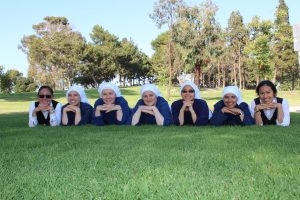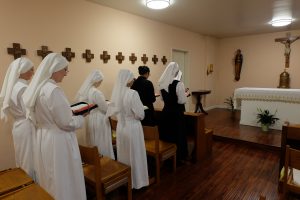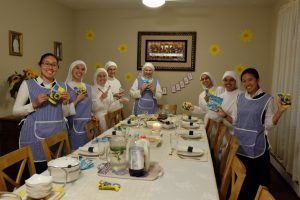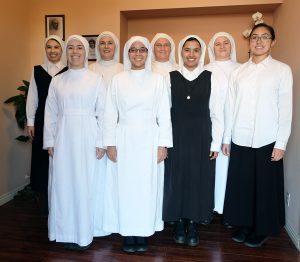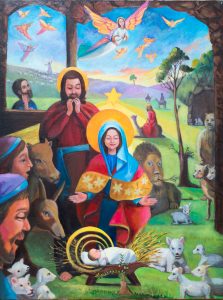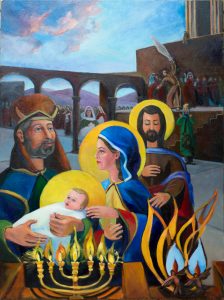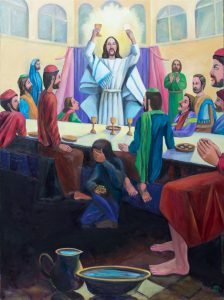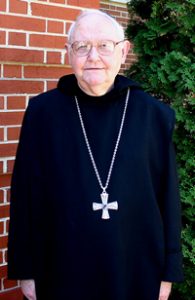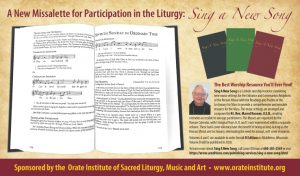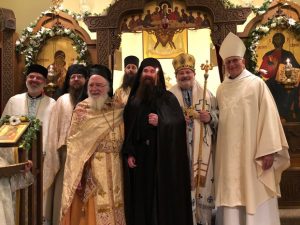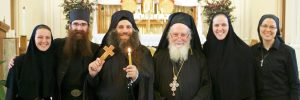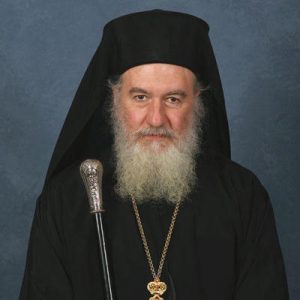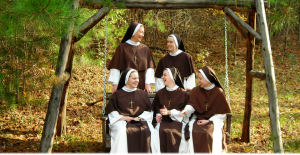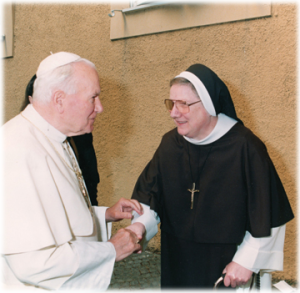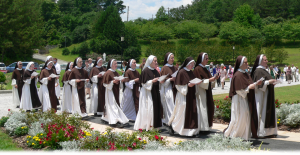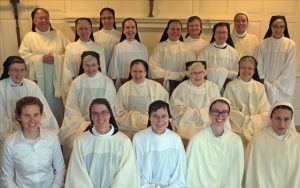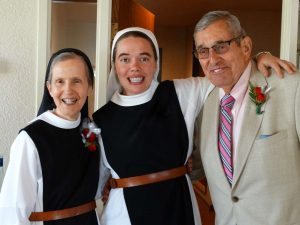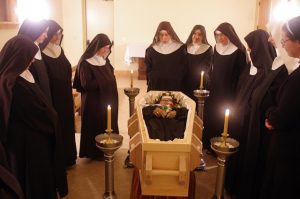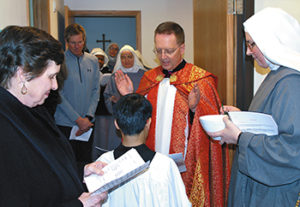J.M. ♰ J.T. April 2019
Carmel of the Holy Face of Jesus Discalced Carmelite Nuns
2051 91st. St. SE
Hague, ND 58542
Phone: 701-336-7907
Dear Friends and Benefactors of Carmel,
Praised be Jesus Christ! When we first came to the Diocese of Bismarck 5 years ago, we enthusiastically set about arranging things so that we could remain for at least 100 years and all of you have been so supportive and generous in helping us. One of the first things we did was to establish the boundaries of our enclosure area which is very important to cloistered contemplative religious. A privacy fence and a chain link fence were put up and many trees were donated and planted. With all the proper permissions we began planning for a monastery that would house all the nuns that would soon be entering. We even obtained 2 mobile homes — one to temporarily serve as a Novitiate and one for a Guest House. God was blessing these efforts and we thought that God was answering the prayer that all of you have been saying with us for the permanent establishment of the Carmel of the Holy Face of Jesus.
Yet, a very short time ago, we have been faced with the possibility that maybe the answer to this prayer is no — such are the mysterious designs of God’s Will. We are not obliged to understand why things turn out the way they do but just to cooperate with them when His Will becomes apparent. So it is with great sadness that we are writing to inform you of the decision that has been made by our Superiors to close the Carmel of the Holy Face of Jesus. (The voice of our superiors is a most sure sign of the Will of God.) We do not have the required minimum number of nuns to remain open. With the Instruction for contemplative nuns (Cor Orans) which was issued from our Superiors in Rome in May of 2018, the minimum number of Professed Sisters required in order to be able to have a Novitiate and receive new members is 5. We have only 4 and our Monastery in Alexandria, South Dakota (from which we originally came) does not have any other Sisters to send to us. It is on this account that we are having to return to South Dakota.
Though the closing of the Carmel of the Holy Face of Jesus comes as a great disappointment to us and to all of you, we need to rely totally on our Faith in God that He is working some marvelous wonders of sanctity through this sudden turn of events. Trusting in the Goodness of God who has provided so bountifully for us these past 5 years, we cannot stop trusting Him now. Trusting in the Lord does not mean that if we pray the right prayer long enough and fervently enough that God will change His mind and let us stay. Trusting in God means believing that God is working through these circumstances to accomplish His loving plan for each one of us and that obeying our superiors will be the best thing for us… even if we don’t understand right now why it has to happen this way. Fortunately, as you have heard from us many times before, our main objective in establishing a monastery here was not just to build a monastic structure for ourselves – we have wanted to build faith in the hearts of individuals, of families and of parishes throughout the diocese of Bismarck and all of you who write and call from across the United States and beyond. This has been our main goal and we will continue to strive to fulfill it just the same, but from a different geographical location. There are no state boundaries where God’s love is concerned. You will ever have a special place in our hearts and prayers. We cannot but marvel at the bounteous Providence of God that we have experienced through the goodness and kindness of each one of you from the very day of our arrival in Hague up to this present moment, and we ask our most loving Father to abundantly reward each one, filling you to overflowing with His choicest blessings, as indeed we know He will.
There are, of course, a number of practical matters that must be taken care of in this process:
1) Mass stipends: Many people have sent us requests for Masses and our remaining time here will not be sufficient to have them all offered in our Chapel. Any Masses that are left will either be entrusted to our Chaplain, Fr. Leonard Eckroth, or sent to the priest at the Bismarck mission in Kenya.
2) Perpetual Enrollments: Those who have been enrolled in the perpetual prayers of the Sisters of the Carmel of the Holy Face of Jesus will now be added to the enrollment register in the Monastery of Our Mother of Mercy & St. Joseph in Alexandria, S.D., to which we will be returning. Please be assured that those perpetual prayers WILL CONTINUE to be offered!
3) Donated items: If anyone has donated something to the Carmel of the Holy Face of Jesus which is of sentimental value to themselves and they would wish these items to remain in a convent here in North Dakota please contact us as soon as possible, no later than June 15th. (701-336-7907) All those who have generously given to us will now be considered benefactors of our Sisters in Alexandria as well and will remain in our grateful prayers.
4) Building Fund: We had already contracted with our architect for the design/development of phase one before we received the news that we might be returning to Alexandria, and since the decision was not yet definitive, the work proceeded as agreed upon. Thus, all “donor designated” funds that were set aside for the building project have in fact been used toward planning for that intended end. If our present situation, so different from the hoped-for results of your generous gifts, presents a difficulty for those who donated to the building project, or for any other of our donors, please contact us and we will see what we are able to do. All the remaining funds of the Carmel of the Holy Face of Jesus will now provide for us at the Monastery of Our Mother of Mercy and St. Joseph in Alexandria, SD.
5) Present correspondence: Due to the many preparations needed for our return to Alexandria (which is scheduled for late summer), we will be unable to continue our correspondence beyond necessary business. Please be assured of our continued prayers for ALL of your intentions, despite our inability to respond by letter.
6) Future correspondence: For those of you who would like to continue participating in Carmelite Novenas and in requesting prayers throughout the year, you may contact us at the following address:
Carmelite Monastery
P.O. Box 67 a
Alexandria, S.D. 57311
You may also call in prayer requests at: (605) 239-4382.
We give thanks to our Father in Heaven for the countless blessings He has showered on us during our time in North Dakota and we ask Him to continue to bless all of you for your kind charity towards us. We ask you to join us in praying daily the enclosed Prayer for Vocations to the Contemplative Life, entreating Our Blessed Savior to renew and increase the contemplative life and, thereby, His whole Mystical Body, the Church. May our good Jesus grant that through an abundant outpouring of His Holy Spirit in our day, true contemplative vocations would abound, making it possible for the Diocese of Bismarck to one day have her own contemplative monastery.
May the Lord bless you and keep you.
May the Lord make His Face to shine upon you,
and be gracious to you.
May the Lord lift up His Countenance upon you,
and give you peace.
Num. 6:24-26
Gratefully in Jesus, Mary and St. Joseph
Mother Mary Baptist of the Virgin of Carmel, O.C.D. and Community
Like this:
Like Loading...
 The ebook answers these questions:
The ebook answers these questions: In this nine-day novena of reflections, you will find a saintly guide – St. Jane de Chantal, co-foundress of the Visitation order – to walk with you on your discernment journey.
In this nine-day novena of reflections, you will find a saintly guide – St. Jane de Chantal, co-foundress of the Visitation order – to walk with you on your discernment journey.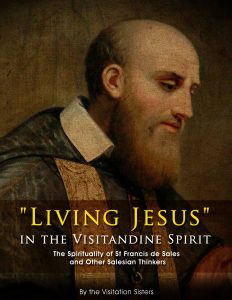 The wisdom of St. Francis de Sales, carried forward by his spiritual descendants over the centuries, is available in this easy-to-read collection of 25 essays.
The wisdom of St. Francis de Sales, carried forward by his spiritual descendants over the centuries, is available in this easy-to-read collection of 25 essays.